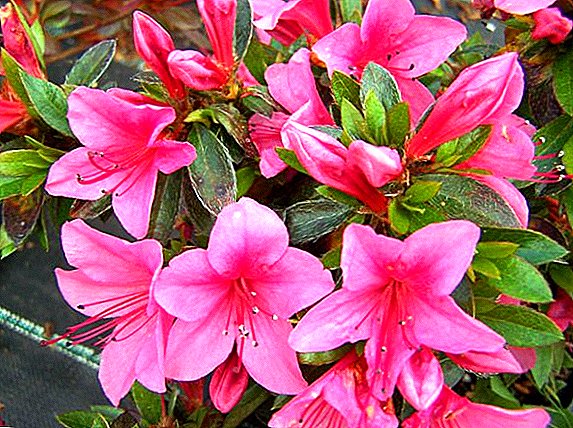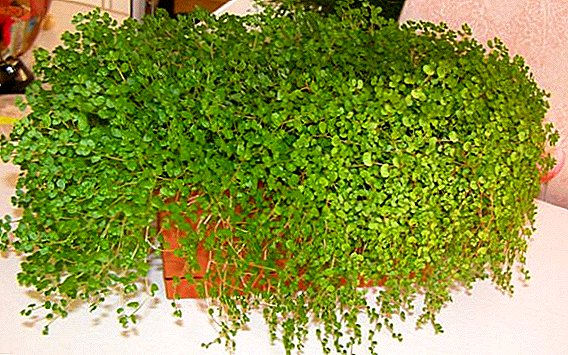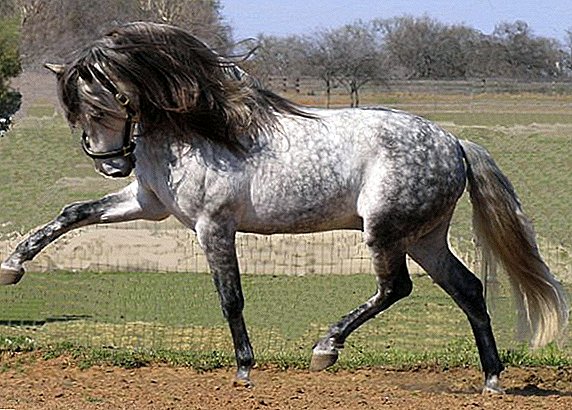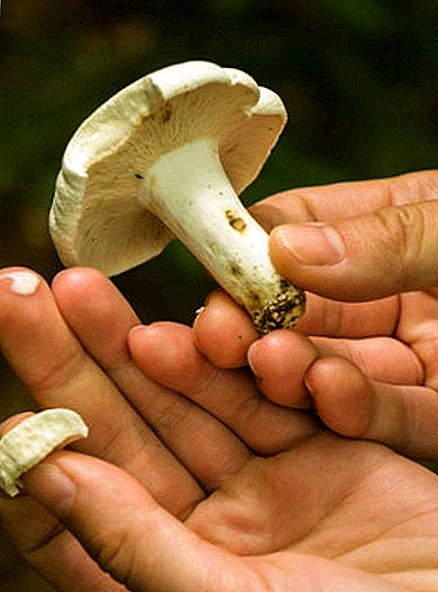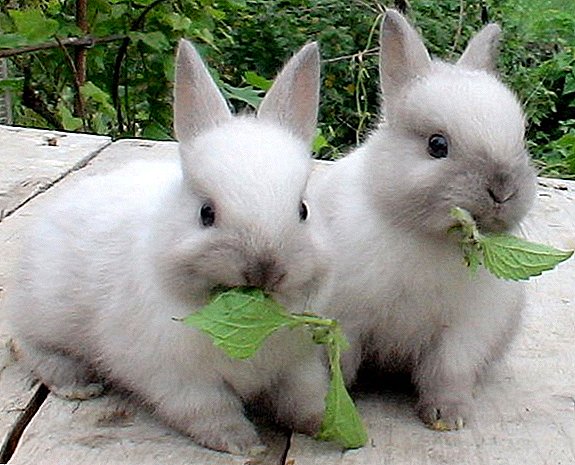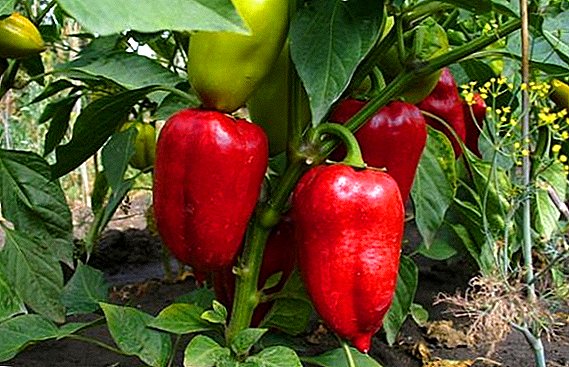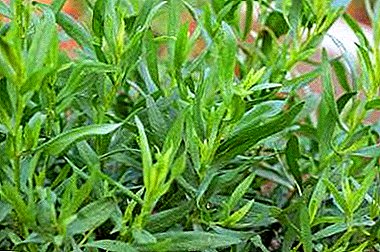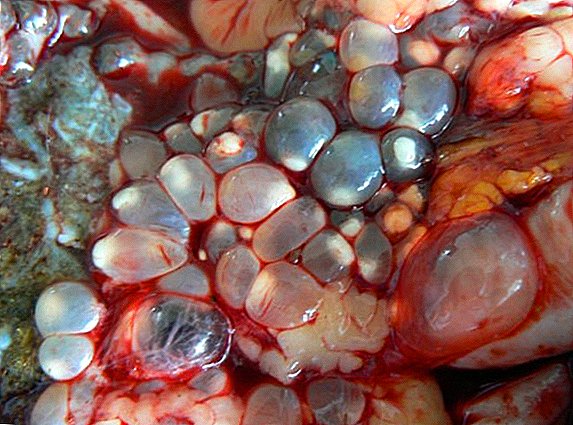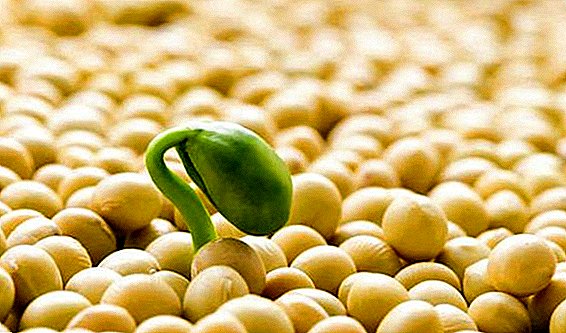 Soy is a valuable food and feed crop, it is also used as a raw material for industrial production. Due to high yields, high protein content and a wide range of applications, soybeans have become ubiquitous. World soybean production reaches nearly 300 million tons and continues to grow annually. To learn how to grow legumes on your site, let's talk further.
Soy is a valuable food and feed crop, it is also used as a raw material for industrial production. Due to high yields, high protein content and a wide range of applications, soybeans have become ubiquitous. World soybean production reaches nearly 300 million tons and continues to grow annually. To learn how to grow legumes on your site, let's talk further.
Culture description
In agriculture, one type of soy is popular, which is divided into three subspecies: Manchu, Japanese and Chinese. The homeland of this plant is the countries of East Asia, where it has been grown for more than 7 thousand years. 
Appearance
Soybean belongs to the family of legumes and is an annual herb. The stalk is branched, spreading, reaches 50-80 cm in height, but there are dwarf species (with a height of the stem up to 25 cm) and gigantic (with a height of the stem up to 2 m).
The legume family includes such plants as clitoria, green beans, clover, herring bean, white beans, dolichos, royal delonix, peas, lupins.
The root system is pivotal, the main root is short, from which many lateral processes branch. Roots can go deep into the soil by 2 meters.
The leaves are trifoliate, varying in shape and size: they can be from 1.5 to 12 cm in width, from 4 to 18 cm in length. The form varies from round, ovate to lanceolate.
Flowers are located in the axils of the leaves, miniature, white or purple, odorless.  Pods up to 6 cm in length, light brown or brown shade, contain 3-4 seeds inside. Soybean seeds can be yellow, green, brown or black, oblong or rounded.
Pods up to 6 cm in length, light brown or brown shade, contain 3-4 seeds inside. Soybean seeds can be yellow, green, brown or black, oblong or rounded.
Characteristic
Soybean has very high yields, which continue to grow thanks to the work of breeders. The average yield of this crop per hectare is 2.2-2.6 tons, but depending on the climatic conditions and care, up to 4-4.5 tons per hectare can be harvested.
The leaders of world production and export of soybeans are the USA (30% of world production), Brazil and Argentina. Also, soybeans are grown on a large scale in the countries of East Asia (China, Indonesia, India), Ukraine and Russia, and the countries of Latin America (Uruguay, Bolivia, Paraguay). 
By the duration of the growing season there are such varieties:
- early maturing (80-100 days);
- early (100-120 days);
- middle ripening (120-140 days);
- late ripening (140-150 days).
Did you know? China consumes more than 2/3 of world soybean production. Such a huge demand for the product arose as a result of the growth of the agricultural industry and the high demand for feed for livestock.
Do I need soy at the cottage
So far, this legume culture is not particularly popular among summer residents; moreover, when people mention it, many people have bad associations with supposedly meat products, which actually contain only soy.
Soybean is considered a field crop and in the vast majority of cases it is grown on an industrial scale, but it is quite possible to grow a legume on its own plot. 
There are several reasons for this:
- ease of cultivation;
- soil purification from weeds (as soy is a tilled crop);
- soil saturation with nitrogen and nutrients for the further cultivation of other crops;
- good yield.
To get a rich harvest, it is necessary to choose varieties in accordance with the climatic conditions of their area.
Find out what soybean meal is.
Conditions for growing soybeans
Choosing the right place and soil will greatly increase the chances of a good harvest. It is also important to analyze which crops were grown on the site earlier, as soy is not compatible with some plants. 
Location selection
This plant loves light and warmth., on these indicators will depend on the intensity of photosynthesis, biological fixation of nitrogen, plant nutrition, and ultimately yield. For planting you need to choose a well-lit area.
It is also important to bear in mind that soy is a pronounced representative of short day plants. This means that the best time for fruiting and flowering is the duration of the night time from 12 hours. If daylight hours increase, the bloom of the bean slows down.
Soil requirements
In general, soybean is not demanding on the soil - it can grow even in poor sandy soils, but its yield will be extremely low. Best of all, the plant itself feels in black earth and chestnut, as well as reclaimed turf soil.  The best yields of grain and green parts can be obtained on fertile soils rich in minerals and calcium, with good drainage and air exchange. Optimal plant a plant on soils with a neutral or slightly alkaline pH.
The best yields of grain and green parts can be obtained on fertile soils rich in minerals and calcium, with good drainage and air exchange. Optimal plant a plant on soils with a neutral or slightly alkaline pH.
Learn about the importance of soil acidity, how to determine acidity, how and what to deoxidize.Without reclamation, soybean should not be planted on these types of soil:
- on acidified soils;
- on marshy ground;
- on salt marshes.
Important! Soybean is very sensitive to an excess of moisture: close bedding of groundwater and short-term flooding can greatly weaken the root system and deprive the plant of food, resulting in crops that are weak, painful and inferior. Sometimes a strong over-wetting of the soil can completely destroy the entire crop.
It is also very important to take care of spring and autumn soil preparation. These include the following stages: peeling, plowing and fertilizing. The first two stages provide loosening of the earth, thanks to which it is saturated with oxygen and gets rid of weeds, and it becomes easier for the roots to germinate.  As a fertilizer you need to make humus. In the spring, before planting soybeans, you need to harrow the earth to a depth of 6 cm. This will preserve moisture in the soil, finally remove weeds and level the surface for a convenient and quick planting.
As a fertilizer you need to make humus. In the spring, before planting soybeans, you need to harrow the earth to a depth of 6 cm. This will preserve moisture in the soil, finally remove weeds and level the surface for a convenient and quick planting.
The best predecessors
In the middle lane, the best precursors of legumes are such plants:
- potatoes;
- sugar beet;
- corn;
- grass grasses;
- winter wheat and other grains.
By the way, these crops, as well as millet are best planted at the site of soybean cultivation, that is, it is useful to alternate these plants on the same piece of land. Soy can be planted on one plot for 2-3 years without damage to the soil.
After this period, the soil needs a 2-year rest, during which the soil is sown with a different crop. 
It is important to know which plants to plant soybean after:
- cabbage of different types;
- rape;
- sunflower;
- leguminous crops;
- legumes (clover, alfalfa, sweet clover).
Sowing rules
Compliance with agricultural technology will allow even a small area to get a decent crop of legumes. Next, we consider how to prepare the seeds and the soil, how to calculate the time, and also find out the scheme of planting soybean plants.
Did you know? Soy sauce, prepared by fermentation of beans, has a special name for the taste "umami". Umami - meat taste - is considered one of the base, along with salty, sour, sweet and bitter.
Optimal timing
The sowing time is determined by the degree of heating of the upper soil layers.  It is optimal to plant the plant when the earth warms to 10-15 ° C, however, if there is a rapid warming, the culture can be planted at a temperature of 6-8 ° C.
It is optimal to plant the plant when the earth warms to 10-15 ° C, however, if there is a rapid warming, the culture can be planted at a temperature of 6-8 ° C.
Typically, such a temperature regime is set at the end of April - the first half of May, but you need to be guided solely by the weather conditions of your region. If at the stage of germination of shoots frost occurs, sowing may die.
If you plan to plant several different varieties, you should start with the late ripening and last plant the early ripening species.
If you sow the grain too early (in cold soil), the risk of disease and pest damage increases significantly, the bushes will be weak, long and poor for the beans. With a correctly calculated planting time, seedlings appear for 5-7 days.  If after 9 days there is no germination, this indicates planting the plant too early.
If after 9 days there is no germination, this indicates planting the plant too early.
Seed preparation
In industrial conditions of cultivation, seeds are planted before planting with special preparations, the amount of which is calculated per ton of seed. Of course, at home, when you gather to grow a very small amount of legume plants on the site, this is not possible.
However, if you get high-quality and healthy seed in special stores, chemical treatment can be avoided.
Mandatory preparatory procedure is the processing of soybean microbiological inoculants. Thanks to the procedure, the roots of the plant will be filled with nitrogen for the entire growing season. The drugs are sold in specialized stores for the garden and vegetable garden and there are two types: dry inoculants on a peat base and liquid concentrates. 
Important! Remember that you need to process the seeds immediately before sowing (12 hours). Do not allow the sun to hit the treated seed!
Sowing scheme
Commercially, planters are used for sowing legumes, but in a small home area, this process takes place manually. At the site it is necessary to make grooves, the distance between which is determined by the variety of soybean and the size of the bush.
For most early ripening varieties, a distance of 20-40 cm is sufficient; if you use a late-ripening variety, the distance between the rows increases to 60 cm. Moisten the furrows with room temperature water.
The depth of the seed is 3-5 cm - planting soy 6 cm and more deeply will be risky, because you can not wait for the seedlings.  It is necessary to observe the distance between the seeds up to 5 cm. This is a rather thick sowing, but it is worth taking into account that some of the seeds will not germinate. If the seedlings are very thick, they can always be thinned out, keeping the distance between the shoots to 20 cm.
It is necessary to observe the distance between the seeds up to 5 cm. This is a rather thick sowing, but it is worth taking into account that some of the seeds will not germinate. If the seedlings are very thick, they can always be thinned out, keeping the distance between the shoots to 20 cm.
It should be borne in mind that soybeans require enough space and light for normal development, therefore the distance between the bushes should be large. Plants should not overshadow each other.
Care culture
The main rules of care include:
- Watering. In general, soybean is considered a drought-resistant plant and at first does not need additional watering. The main thing is that at the time of planting in the soil was enough moisture. However, watering becomes necessary starting from the end of June, when soybeans have an active period of bud formation, and the daytime temperature reaches 30 ° C. Water consumption is as follows: 5 liters per 1 m2.

- Mulching land. This procedure helps to retain moisture in the ground. For mulching you can use humus or peat. If you do not carry out mulching, it is necessary to loosen the ground with a hoe after irrigation.
- Weed control. It is especially important to prevent the appearance of weed plants in the first month and a half after planting, since soybean sprouts are still very weak and weeds can easily clog them. Weeds can be removed by chemical treatment or manually. Herbicides (for example, "Roundup") can be applied twice: a few days later and a month after planting.
Such drugs as “Butizan”, “Singer”, “Biceps Garant”, “Herbitox”, “Select”, “Targa Super”, “Lintur”, “Milagro”, “Dicamba”, “Granstar”, "Helios", "Glyphos", "Banvel".
- Harrowing or loosening. The first method is suitable for large areas, the second - for processing a compact area. Harrowing is carried out several times: 4 days after sowing, after the formation of two leaves (when the germ reaches 15 cm) and after the formation of the third leaf.
- Cold protection. In the first weeks after planting, all sowing work can go down the drain even from a minor freeze. Therefore, you need to carefully monitor the weather - in case of cold rains to -1 ° C, crops should be covered.
Harvesting
After 100-150 days from the moment of planting (depending on the variety), you can start harvesting. 
Signs of ripeness
Early ripening varieties can be harvested as early as mid-August; late-ripening species ripen in mid-late September.
The fact that the time has come to harvest, can be found on these grounds:
- the pods are easily divided and the seeds are simply separated;
- the plant turns yellow;
- leaves fall.
Important! You can not delay the harvest - although soybean pods crack less than other leguminous crops, with a delay in harvesting there may be significant losses of beans.
Harvesting methods
On an industrial scale, special machines are used for harvesting soybeans, but you can manually harvest the crop on your plot. It does not take much time, and the loss of legumes will be minimal.  It is best to cut (mow) the plant near the root, leaving the root part in the ground. Special thickening forms on the roots - microorganisms living there can process nitrogen and enrich the soil with it. This will have a positive effect on the subsequent harvest in this area.
It is best to cut (mow) the plant near the root, leaving the root part in the ground. Special thickening forms on the roots - microorganisms living there can process nitrogen and enrich the soil with it. This will have a positive effect on the subsequent harvest in this area.
After cutting, the plants are folded in bunches and suspended in a dry, well-ventilated room for ripening. For this purpose you can use a barn or an attic.
This method is extremely effective if during the harvest period there were rains and the seeds were too saturated with moisture. After a few weeks, the pods can be threshed.
Soybean storage features
The main rule of long-term storage of soybeans is the control of air humidity. The fact is that soy is very hygroscopic, because the humidity in the room should not exceed 10-13%.  Under these conditions, the shelf life of legumes reaches 1 year. If the humidity is 14% or more, the shelf life of the product is reduced to 3 months.
Under these conditions, the shelf life of legumes reaches 1 year. If the humidity is 14% or more, the shelf life of the product is reduced to 3 months.
Store the seeds in fabric bags or cardboard boxes in a dark place. For this purpose, a pantry, dry cell, or a glazed balcony or the furthest shelves of kitchen cabinets are ideal.
A few more important rules for a successful harvest:
- beans must be carefully picked and eliminated spoiled, rotten and damaged;
- Keep beans away from other foods;
- if any smell starts to emanate from soy, it indicates the spoilage of the product.
 From soybeans you can cook a variety of dishes, ranging from meat substitutes and ending with coffee. Therefore, it is convenient to always have on hand the stocks of useful bean product.
From soybeans you can cook a variety of dishes, ranging from meat substitutes and ending with coffee. Therefore, it is convenient to always have on hand the stocks of useful bean product.Despite some features of agricultural technology, in general, the cultivation of soybeans is not difficult, and even a beginning summer resident can get a good crop of this crop.
Feedback from network users
Sow and cleaned soybeans, and more than once. Sowing and growing is half the battle, everything is more or less clear. With cleaning up the trouble. I can’t clean up quickly (I have Dona), God forbid 5 ha per day, and then if the fields are clean. Losses are not weak either (beans crack and crumble right in the header). The stem itself is like a rope - once it was even clicked, the drum was beaten so that even its shaft was bent. There are no perfectly smooth fields - the lower beans often remain. The year before last, there was an outbreak of acacia fire in the Kuban, so I didn’t even have to clean it up - I blew off everything. And the yield was only once under 20. So not everything is so fun. But this year I will sow again - there is nothing more, hemp is not allowed.Valera23
//fermer.ru/comment/151266#comment-151266
Sowed szp-3,6 per meter from 13-15pcs. over Harmony weeds but early phases. Pivot once tried well, but on the overlap aftereffect on the winter, so that it is extraordinary. On the firearm BI-58 plus the contactee. Widespread sowing failed, but the “Soybean Complex” recommended 70 32 units.CES
//forum.zol.ru/index.php?s=3f6f1cc8cfb3ed373744ee18052471a2&showtopic=4160&view=findpost&p=111340


